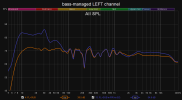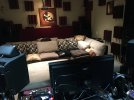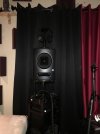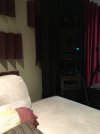KSTR
Major Contributor
Hi,
Recently, I promised I'll present my trusted test signals for evaluation of room modes, finding best positions for speakers and listener, check for distortion/rattling etc.
This was a project I did 20 years ago before EQ'ing was commonplace, let alone full digital "room correction".
An important feature was that I tried to highlight the temporal distortion that comes with room modes, something which cannot easily be evaluated with steady-state sine test signals. These are specifically designed burst sequences, ranging from 27.5Hz to 440Hz, spaced in quarter-note distances.
The usage was optimized for CD-players (preferably capable to display CD-text info) with remote control because other digital playback sources also weren't commonplace.
Using a remote control of any sorts which can be blindly operated, to quickly navigate through the tracks with instant playback starting after a "next" or "previous" select, is paramount for convenience and success. You don't want to waste any effort on navigation since the main task is well-focussed concentrated listening.
Download Link (containing a bunch of FLAC files, some instructions and a GIF for a CD index sheet).
Source and executable files (Windows) for the C programs used to make the original .WAV files are available on request.
Information :
LF_TEST V1.0
-- Low Frequency Sine-Burst Test Signals for Room and Loudspeaker Evaluation --
HOW TO USE THE CD (or the signals in general)
=============================================
MOST OF ALL :
BE CAREFUL WITH THE PLAYBACK VOLUME!!
YOU MIGHT EASILY DESTROY YOUR WOOFERS.
ALL SIGNALS ARE RECORDED AT FULL LEVEL!!
1) GENERAL:
A CD-player with CD-Text option for track name and a remote control is most convenient for usage of these test signals. The CD uses all 99 tracks allowed by the CD standard which any CD-player should be able to handle.
You should be in a relaxed state of mind and the environment should be quiet but not dead silent -- some background random noise is helpful to better detect the structure of the modulations because of the psychoacoustic compression effect; the noise gets masked away by the LF signal in the specific patterns thus making them more readily audible.
To make yourself accustomed with the CD's signals, you might want to listen to some tracks at first with headphones to memorize the target sound of the patterns more easily. Start with a moderately low frequency like track #23 (49Hz).
Make sure your speakers are really off before turning up the volume of the phones!! Don't overdo it as you might damage your phones also and your ears will thank it, too.
For the first time of usage you may want to reserve at least an hour for testing.
If you happen to get bit by the "burst bug" you may find yourself listening for many hours, especially when you start to move your speakers and listening position around.
2) Now start with the first track, the noise, to set a rather low listening level and for general verification that your setup is working well. You might already notice some frequencies "sticking out".
3) Play track #2, the sweep. The track has 3 seconds of silence at the beginning, afterwards the low rumbling of 27.5Hz starts without warning.
DON'T TURN UP THE VOLUME because you think at first it were too low to hear the low tone. Wait and watch woofer's motion before you decide to turn it up!
The sweep is timed such that the current position (in seconds as displayed) by the player indicates the track number of the corresponding sequence for the current frequency we're at, in the sweep. So if you hear a drone or a suck-out or any other interesting stuff at, say, 00:23 and 1:12, the corresponding detail sequence tracks are track #23 and track #72 (60+12).
The sweep is in mono, so you will likely find the phantom image to heavily go off-center at specific frequencies, an indicator of some L/R asymmetry in your setup (typically not easy to nail down what it causes it, though).
4) THE STRUCTURE OF THE BURST SEQUENCES, for each specific frequency:
There are 97 sequences on the CD, ranging from 27.5Hz to 440Hz in quartertone steps, 24 sequences per octave. On the CD index sheet the frequencies their musical notes are given.
Each sequence is based on a burst of several cycles with raised cosine fade-ins/fade-outs of 2 periods. This allows a gradual start and stop of the burst, to avoid detracting clicks.
Several parameters are varied systematically within each sequence:
The sequence consist of four blocks:
If you have a .WAV editor load the first burst sequence (27.5Hz) to get a visual idea what is happening, additional to the proposed headphone listening check.
These variations create a big pool of possible signal combinations to check the effect of room modes. The inverted parts are for double checking mostly if you have modes with strong sideways components.
This can also be checked with one speaker disconnected which you should try as well.
NOTE: If you have mono subwoofer(s) there will be NO SIGNAL if the frequencies are low, for those out-of-phase section (the second half of the four block set per sequence).
Feel free to walk along the room and put your ear at specific positions (including different heights).
After some time of usage (say after two or three sessions) you will be familiar with the LF response pattern in both level and temporal (time-domain) aspects. The burst sequences will develop many interesting patterns, even some kind of specific rhythm.
Compare with headphones at times to re-check how it really should sound like. You will then note that some music with specific bass rhythms may sound corrupted, out of time and without any articulation, while others may sound extremly tight and punchy. But it may not be the musicians that are responsible for that perceived effect!
Also you will know the musical notes where your setup has problems and it will become clear why songs sound lame in the chorus because the bass line hits a drop-out region.
Finally you will start to move your speakers around as well as the listening position including height of both to see if you can make the overall response more benign and even. Quite often positions can be found where this can be achieved and even 10cm (4") can make a big difference (for symmetry problems especially, as the geometric center line of room does not need to conincide with the acoustic center when L/R walls are different in stiffness.
Take care that you check and verify other aspects of reproduction like reflections, stereo imaging, tonality in the midrange etc, especially if you have a two-speaker-only setup (no subs). You may and up with better bass response but otherwise degraded performance from where you started.
Don't get too disappointed if you don't seem to find any good bass setup and smack-center mono image, with real music it will not sound that bad, typically.
Also if you decide to use EQ to flatten the percieved response don't overdo it. EQ'ing is a big topic of it's own that would bloat this text even more. Same goes for the theory about modes, the internet forums are full of information about this and books are also available.
Have fun!
Recently, I promised I'll present my trusted test signals for evaluation of room modes, finding best positions for speakers and listener, check for distortion/rattling etc.
This was a project I did 20 years ago before EQ'ing was commonplace, let alone full digital "room correction".
An important feature was that I tried to highlight the temporal distortion that comes with room modes, something which cannot easily be evaluated with steady-state sine test signals. These are specifically designed burst sequences, ranging from 27.5Hz to 440Hz, spaced in quarter-note distances.
The usage was optimized for CD-players (preferably capable to display CD-text info) with remote control because other digital playback sources also weren't commonplace.
Using a remote control of any sorts which can be blindly operated, to quickly navigate through the tracks with instant playback starting after a "next" or "previous" select, is paramount for convenience and success. You don't want to waste any effort on navigation since the main task is well-focussed concentrated listening.
Download Link (containing a bunch of FLAC files, some instructions and a GIF for a CD index sheet).
Source and executable files (Windows) for the C programs used to make the original .WAV files are available on request.
Information :
LF_TEST V1.0
-- Low Frequency Sine-Burst Test Signals for Room and Loudspeaker Evaluation --
HOW TO USE THE CD (or the signals in general)
=============================================
MOST OF ALL :
BE CAREFUL WITH THE PLAYBACK VOLUME!!
YOU MIGHT EASILY DESTROY YOUR WOOFERS.
ALL SIGNALS ARE RECORDED AT FULL LEVEL!!
1) GENERAL:
A CD-player with CD-Text option for track name and a remote control is most convenient for usage of these test signals. The CD uses all 99 tracks allowed by the CD standard which any CD-player should be able to handle.
You should be in a relaxed state of mind and the environment should be quiet but not dead silent -- some background random noise is helpful to better detect the structure of the modulations because of the psychoacoustic compression effect; the noise gets masked away by the LF signal in the specific patterns thus making them more readily audible.
To make yourself accustomed with the CD's signals, you might want to listen to some tracks at first with headphones to memorize the target sound of the patterns more easily. Start with a moderately low frequency like track #23 (49Hz).
Make sure your speakers are really off before turning up the volume of the phones!! Don't overdo it as you might damage your phones also and your ears will thank it, too.
For the first time of usage you may want to reserve at least an hour for testing.
If you happen to get bit by the "burst bug" you may find yourself listening for many hours, especially when you start to move your speakers and listening position around.
2) Now start with the first track, the noise, to set a rather low listening level and for general verification that your setup is working well. You might already notice some frequencies "sticking out".
3) Play track #2, the sweep. The track has 3 seconds of silence at the beginning, afterwards the low rumbling of 27.5Hz starts without warning.
DON'T TURN UP THE VOLUME because you think at first it were too low to hear the low tone. Wait and watch woofer's motion before you decide to turn it up!
The sweep is timed such that the current position (in seconds as displayed) by the player indicates the track number of the corresponding sequence for the current frequency we're at, in the sweep. So if you hear a drone or a suck-out or any other interesting stuff at, say, 00:23 and 1:12, the corresponding detail sequence tracks are track #23 and track #72 (60+12).
The sweep is in mono, so you will likely find the phantom image to heavily go off-center at specific frequencies, an indicator of some L/R asymmetry in your setup (typically not easy to nail down what it causes it, though).
4) THE STRUCTURE OF THE BURST SEQUENCES, for each specific frequency:
There are 97 sequences on the CD, ranging from 27.5Hz to 440Hz in quartertone steps, 24 sequences per octave. On the CD index sheet the frequencies their musical notes are given.
Each sequence is based on a burst of several cycles with raised cosine fade-ins/fade-outs of 2 periods. This allows a gradual start and stop of the burst, to avoid detracting clicks.
Several parameters are varied systematically within each sequence:
- the total burst length starting with 1 second then getting shorter, but no less than 6 periods (2 fade-in, 2 normal, 2 fade-out).
- the gap in between (in multiples of periods) plus the phase relationship between the bursts (so that the next burst starts either in phase with a room hangover or in counter-phase by making the gap half a period longer).
- the interchannel polarity. Either mono or one channel "out of phase".
The sequence consist of four blocks:
- each block starts with long bursts reaching steady state, and long gaps in between the burst, then gap length is successivly shortened.
- the next block basically indentical but has counter-phase gap lengths (x.5 periods instead of integer multiples).
- finally, these two blocks are then repeated again but with one channel inverted, L and R signals are out-or-phase.
If you have a .WAV editor load the first burst sequence (27.5Hz) to get a visual idea what is happening, additional to the proposed headphone listening check.
These variations create a big pool of possible signal combinations to check the effect of room modes. The inverted parts are for double checking mostly if you have modes with strong sideways components.
This can also be checked with one speaker disconnected which you should try as well.
NOTE: If you have mono subwoofer(s) there will be NO SIGNAL if the frequencies are low, for those out-of-phase section (the second half of the four block set per sequence).
Feel free to walk along the room and put your ear at specific positions (including different heights).
After some time of usage (say after two or three sessions) you will be familiar with the LF response pattern in both level and temporal (time-domain) aspects. The burst sequences will develop many interesting patterns, even some kind of specific rhythm.
Compare with headphones at times to re-check how it really should sound like. You will then note that some music with specific bass rhythms may sound corrupted, out of time and without any articulation, while others may sound extremly tight and punchy. But it may not be the musicians that are responsible for that perceived effect!
Also you will know the musical notes where your setup has problems and it will become clear why songs sound lame in the chorus because the bass line hits a drop-out region.
Finally you will start to move your speakers around as well as the listening position including height of both to see if you can make the overall response more benign and even. Quite often positions can be found where this can be achieved and even 10cm (4") can make a big difference (for symmetry problems especially, as the geometric center line of room does not need to conincide with the acoustic center when L/R walls are different in stiffness.
Take care that you check and verify other aspects of reproduction like reflections, stereo imaging, tonality in the midrange etc, especially if you have a two-speaker-only setup (no subs). You may and up with better bass response but otherwise degraded performance from where you started.
Don't get too disappointed if you don't seem to find any good bass setup and smack-center mono image, with real music it will not sound that bad, typically.
Also if you decide to use EQ to flatten the percieved response don't overdo it. EQ'ing is a big topic of it's own that would bloat this text even more. Same goes for the theory about modes, the internet forums are full of information about this and books are also available.
Have fun!









